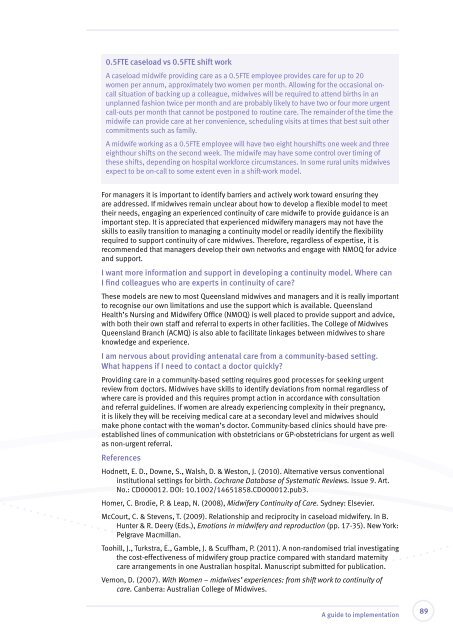Delivering continuity of midwifery care to Queensland women
Delivering continuity of midwifery care to Queensland women
Delivering continuity of midwifery care to Queensland women
Create successful ePaper yourself
Turn your PDF publications into a flip-book with our unique Google optimized e-Paper software.
0.5FTE caseload vs 0.5FTE shift work<br />
A caseload midwife providing <strong>care</strong> as a 0.5FTE employee provides <strong>care</strong> for up <strong>to</strong> 20<br />
<strong>women</strong> per annum, approximately two <strong>women</strong> per month. Allowing for the occasional oncall<br />
situation <strong>of</strong> backing up a colleague, midwives will be required <strong>to</strong> attend births in an<br />
unplanned fashion twice per month and are probably likely <strong>to</strong> have two or four more urgent<br />
call-outs per month that cannot be postponed <strong>to</strong> routine <strong>care</strong>. The remainder <strong>of</strong> the time the<br />
midwife can provide <strong>care</strong> at her convenience, scheduling visits at times that best suit other<br />
commitments such as family.<br />
A midwife working as a 0.5FTE employee will have two eight hourshifts one week and three<br />
eighthour shifts on the second week. The midwife may have some control over timing <strong>of</strong><br />
these shifts, depending on hospital workforce circumstances. In some rural units midwives<br />
expect <strong>to</strong> be on-call <strong>to</strong> some extent even in a shift-work model.<br />
For managers it is important <strong>to</strong> identify barriers and actively work <strong>to</strong>ward ensuring they<br />
are addressed. If midwives remain unclear about how <strong>to</strong> develop a flexible model <strong>to</strong> meet<br />
their needs, engaging an experienced <strong>continuity</strong> <strong>of</strong> <strong>care</strong> midwife <strong>to</strong> provide guidance is an<br />
important step. It is appreciated that experienced <strong>midwifery</strong> managers may not have the<br />
skills <strong>to</strong> easily transition <strong>to</strong> managing a <strong>continuity</strong> model or readily identify the flexibility<br />
required <strong>to</strong> support <strong>continuity</strong> <strong>of</strong> <strong>care</strong> midwives. Therefore, regardless <strong>of</strong> expertise, it is<br />
recommended that managers develop their own networks and engage with NMOQ for advice<br />
and support.<br />
I want more information and support in developing a <strong>continuity</strong> model. Where can<br />
I find colleagues who are experts in <strong>continuity</strong> <strong>of</strong> <strong>care</strong><br />
These models are new <strong>to</strong> most <strong>Queensland</strong> midwives and managers and it is really important<br />
<strong>to</strong> recognise our own limitations and use the support which is available. <strong>Queensland</strong><br />
Health’s Nursing and Midwifery Office (NMOQ) is well placed <strong>to</strong> provide support and advice,<br />
with both their own staff and referral <strong>to</strong> experts in other facilities. The College <strong>of</strong> Midwives<br />
<strong>Queensland</strong> Branch (ACMQ) is also able <strong>to</strong> facilitate linkages between midwives <strong>to</strong> share<br />
knowledge and experience.<br />
I am nervous about providing antenatal <strong>care</strong> from a community-based setting.<br />
What happens if I need <strong>to</strong> contact a doc<strong>to</strong>r quickly<br />
Providing <strong>care</strong> in a community-based setting requires good processes for seeking urgent<br />
review from doc<strong>to</strong>rs. Midwives have skills <strong>to</strong> identify deviations from normal regardless <strong>of</strong><br />
where <strong>care</strong> is provided and this requires prompt action in accordance with consultation<br />
and referral guidelines. If <strong>women</strong> are already experiencing complexity in their pregnancy,<br />
it is likely they will be receiving medical <strong>care</strong> at a secondary level and midwives should<br />
make phone contact with the woman’s doc<strong>to</strong>r. Community-based clinics should have preestablished<br />
lines <strong>of</strong> communication with obstetricians or GP-obstetricians for urgent as well<br />
as non-urgent referral.<br />
References<br />
Hodnett, E. D., Downe, S., Walsh, D. & Wes<strong>to</strong>n, J. (2010). Alternative versus conventional<br />
institutional settings for birth. Cochrane Database <strong>of</strong> Systematic Reviews. Issue 9. Art.<br />
No.: CD000012. DOI: 10.1002/14651858.CD000012.pub3.<br />
Homer, C. Brodie, P. & Leap, N. (2008), Midwifery Continuity <strong>of</strong> Care. Sydney: Elsevier.<br />
McCourt, C. & Stevens, T. (2009). Relationship and reciprocity in caseload <strong>midwifery</strong>. In B.<br />
Hunter & R. Deery (Eds.), Emotions in <strong>midwifery</strong> and reproduction (pp. 17-35). New York:<br />
Pelgrave Macmillan.<br />
Toohill, J., Turkstra, E., Gamble, J. & Scuffham, P. (2011). A non-randomised trial investigating<br />
the cost-effectiveness <strong>of</strong> <strong>midwifery</strong> group practice compared with standard maternity<br />
<strong>care</strong> arrangements in one Australian hospital. Manuscript submitted for publication.<br />
Vernon, D. (2007). With Women – midwives’ experiences: from shift work <strong>to</strong> <strong>continuity</strong> <strong>of</strong><br />
<strong>care</strong>. Canberra: Australian College <strong>of</strong> Midwives.<br />
A guide <strong>to</strong> implementation<br />
89
















